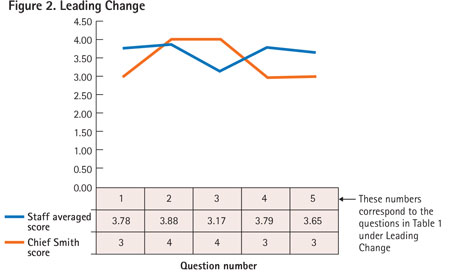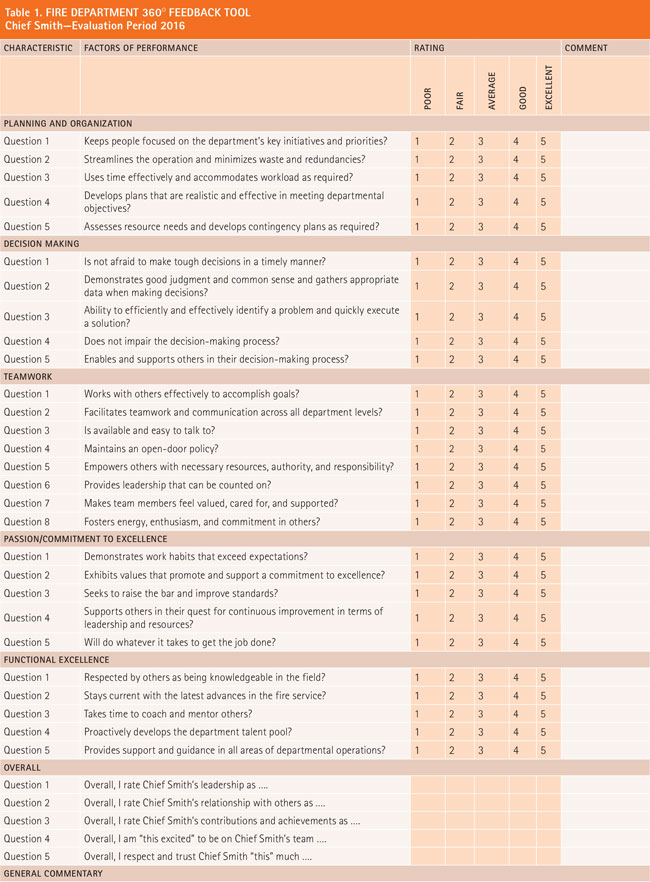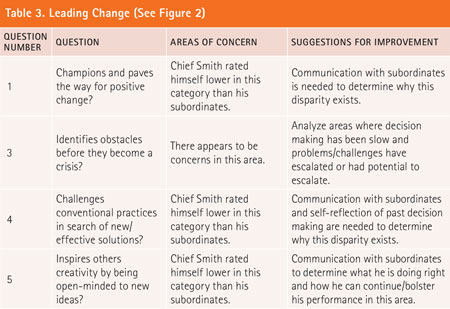
By Craig A. Haigh
Early in my career, it was drilled into me that it is important to get a 360° view of the emergency incident. Experienced officers will tell you that what is seen from the street side may be very different than what is happening in the rear. Tactical decisions based on a singular focus typically result in tunnel vision that can then result in disastrous consequences. We need to get a full view of the job at hand so we can operate efficiently and effectively and bring home all of the players we took to the game.
As we climb the organizational ladder, the job changes, and we find ourselves spending more and more time focused on management tasks and leading people rather than making tactical decisions at emergency incidents. Days are filled with e-mails, meetings, questions from subordinates, calls from the mayor’s/manager’s office, discussions with union leadership, and questions from residents as to why they received a bill for their recent ambulance transport.
In the course of a single day, a fire officer may serve as an emergency responder, an accountant, a human resources manager, a legal expert, a politician, a cheerleader, a marriage counselor, and a boss.1 Most fire service command officers clearly understand the importance of the 360° size-up on the fireground, but how about a 360° of your job performance?

None of us likes receiving our annual performance evaluation. Truth be told, even if you believe that your boss is generally pleased with your performance, there is still a level of anxiety as you get ready to hear someone else’s opinion of the job you have done over the past 12 months. Yet, the performance evaluation is as important as your annual health physical (most of us don’t like it either). The performance review helps make sure that our compass is still pointing in the right direction and we are still meeting the needs of the organization and those we serve. The annual evaluation is a critical management tool designed to help keep us relevant and focused. It should never be a disciplinary tool but rather a teaching tool for continuous self-improvement.
Yet, the evaluations used by many organizations are typically top down. Our bosses review our performance based on a subordinate/supervisor relationship. But what about the opinions of those we lead? Would it be helpful to know how you are perceived by your subordinates? How do their opinions compare against how you believe you are performing? How about whether your management style and the decisions you make are positively or negatively impacting the boots on the ground? One could argue that equally as important as your boss’s opinion are the opinions of those you lead. In the evaluation model used by most fire service organizations, we rarely get the chance to see how our performance is perceived by our people. That’s where the 360° evaluation tool comes into play.
The Data Collection Process
By its very definition, the 360° evaluation is designed to seek input from all involved pertinent parties. It starts with the one being rated, it moves to gain the input of subordinates and coworkers, and then ultimately the information gleaned comes back to the one being rated in a comparative format. To accomplish this, the one being rated is given the 360° evaluation tool and asked to rate himself in a variety of categories. Likewise, several of his subordinates and coworkers are given the same rating tool and asked to evaluate the subject in the same categories. The evaluations are then collected and compared against each other by a third party. A finalized report is generated that shows the details of the comparison and the revealed gaps in perception. This analysis, coupled with some significant self-reflection, is designed to help the one being evaluated to see his performance through the eyes of the team.
How the 360° process is implemented varies from organization to organization and from individual to individual based on the individual’s overall sphere of influence. In a small 30- to 40-member volunteer/paid-on-call department in which the governing board is using the tool to evaluate the performance of the fire chief, all members of the organization may complete the evaluation tool. Another department may break the evaluation process into work groups.
As an example, a battalion chief managing a shift of 15 to 20 personnel could easily have all members complete the evaluation, but he would exclude those members not assigned to his shift. The process could be modified for a division chief who has 75 to 80 members who indirectly report to him and who are within his sphere of influence. In this case, it might be much more efficient and accurate to obtain a sampling that includes battalion chiefs, the division’s administrative assistant, and select officers and firefighters who interact regularly with the chief. Or, in another case, a large department with multiple battalion chiefs working each day may want to do a peer 360° to determine the perspective of coworkers as it relates to effective daily interaction toward meeting the mission of the department.

When it comes to selection of the evaluation group, there are no specific criteria and model. Each department needs to handle the selection of participants on a case-by-case basis, carefully considering what makes sense for the organization, the information you are looking to obtain, and the administrators/supervisors/officers being evaluated.
The keys to gaining meaningful information from those who are doing the rating are confidentiality and trust. Encourage all parties to share their opinions openly and honestly without fear of retaliation. To accomplish this, the process needs to be a blind data collection process.
As an example, raters are sent the 360° evaluation form electronically; they complete the document, print it out, seal it in an unmarked envelope, and turn it in to a designated individual. This individual is responsible for collection but also maintains a signature sheet whereby all assigned evaluators are tracked to ensure completion of the document. The one being evaluated completes the same 360° evaluation form as the raters except that theirs are marked with his name or some type of designated tracking method. An Internet-based survey system such as SurveyMonkey® or a similar system can be used to accomplish the same goal and is incredibly effective.
The importance is not in how the data are collected but in the quality of the data received. The only two true essential aspects are the following: (1) The process is mandatory and needs to involve each of the assigned raters, and (2) the process needs to be absolutely confidential.

Developing the 360° Evaluation Instrument
When developing the tool, emphasize what is being assessed and the questions you want answered. The tool needs to be concise yet thorough and fairly easy to complete without being overly lengthy. A tool I have used successfully is modeled after one borrowed from private industry.2 It is designed specifically for a high-ranking fire service leader and looks at 12 broad categories. It could easily be modified based on the desired analysis of any given team member (Table 1).

Data Compilation
Once the evaluation instruments are completed and collected, the data analysis process begins. I have found that an Excel spreadsheet works very well. The goal is to use the data to create a line chart that compares the averaged ratings of the evaluators for each category and question against the self-ratings of the one being evaluated. The line chart visually displays the “gap” between performance perceptions. In a perfect world, the two would be identical. In the real world, a “gap” almost always exists. The 360° tool is used to help discover that “gap” so actions can be taken to correct or minimize the distance between the two perspectives. The analysis is not intended to make conclusions on who is right or wrong but to identify perceptions that can be addressed to improve overall performance.
Figures 1 and 2 are examples of the line chart analysis. To help in understanding the process, I created a hypothetical evaluation using the generic “Chief Smith” as our evaluated candidate. Two of the 12 broad categories identified in Table 1 are graphed in Figures 1 and 2. The charts show the “gap” rating for each question asked under the categories of “Fire Department Leadership” and “Leading Change.” The questions referenced as 1-6 and 1-5, respectively, are shown in Table 1 under the first two categories.

Analyses of the two hypothetical scoring categories suggest that both Chief Smith and his subordinates rated his performance in the ranges of average (3) to good (4). This might suggest that his performance is acceptable but not in the “high performer” category. A closer look might suggest the following action items from the divergences noted for the questions with larger variances (Tables 2 and 3).
Comments provided by the evaluators on the 360° evaluation tool should also be shared with Chief Smith. They can be delivered in a variety of ways but, if possible, should be supplied word for word. Looking at them unchanged can help Chief Smith better gauge some of the feelings/perceptions (right or wrong) of his people. Armed with this knowledge, he can make course corrections to his leadership style that will make him significantly more effective.

The 360° evaluation tool is a versatile instrument that can be designed and modified to create a learning tool to assist fire service leaders at all levels. Once the process is completed, the subject being evaluated is now armed with a powerful tool to help him reflect on his individual leadership style and how it is impacting his workers. Based on the information gleaned, coupled with self-reflection, the individual can make adjustments as necessary to do his absolute best. It is also important for supervisors to realize that some of the staff will not like them and will make harsh comments (the reality of being a manager) while others will love them and will make overly positive comments. As you reflect on the comments, you most likely will need to adjust your style to somewhere in the middle.3
Just as on the fireground, the view from the rear may look far worse or significantly better than what you see from the street. The key learning aspect is to realize that to do a strong holistic job and ensure that you are not missing something, you must take a look at all sides so you can adjust your tactics accordingly. Remember, the 360° evaluation is not just for the fireground.
References
1. Haigh, CA. (2015, February). Juggling hats: The multiple responsibilities of managing a volunteer/combination department. Winter Fire College. Symposium conducted at the University of Missouri Fire and Rescue Training Institute, Columbia, MO.
2. 360 Evaluation Tool [Measurement instrument]. (2010). Columbus, OH: ODW Logistics, Inc.
3. Haigh, CA. (2013). Administrator Evaluation Process [report]. Roselle, IL: Medinah Christian School.
CRAIG A. HAIGH, a 32-year veteran of the fire service, is chief of the Hanover Park (IL) Fire Department and a field staff instructor with the University of Illinois Fire Service Institute. He was a finalist for the 2012 International Association of Fire Chiefs Career Fire Chief of the Year and was named the 2012 Illinois Career Fire Chief of the Year. He is an honorary member of the East Dubuque (IL) Fire Department. He has managed volunteer, combination, and career departments; served as interim village manager; implemented intermediate and paramedic services; and is a frequent partner with the University of Illinois Fire Service Institute’s Firefighter Life Safety Research Center. He is a published author; presents at local, state, and national conferences; and is an FDIC International H.O.T. instructor. He has a master’s degree in executive fire service leadership and a bachelor’s degree in fire and safety engineering. He is a graduate of the National Fire Academy’s Executive Fire Officer Program and is a nationally licensed paramedic, an accredited chief fire officer, and a member of the Institute of Fire Engineers.
More Fire Engineering Issue Articles
Fire Engineering Archives

